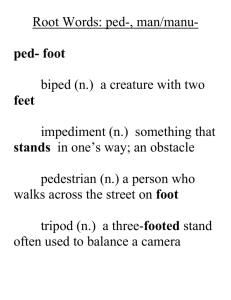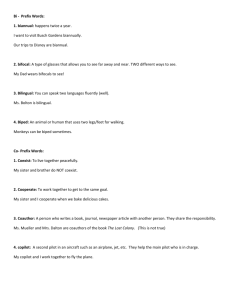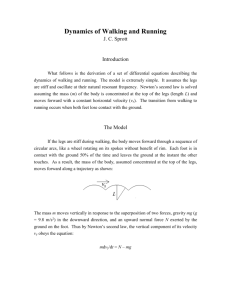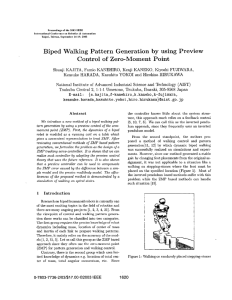Document 13134749
advertisement
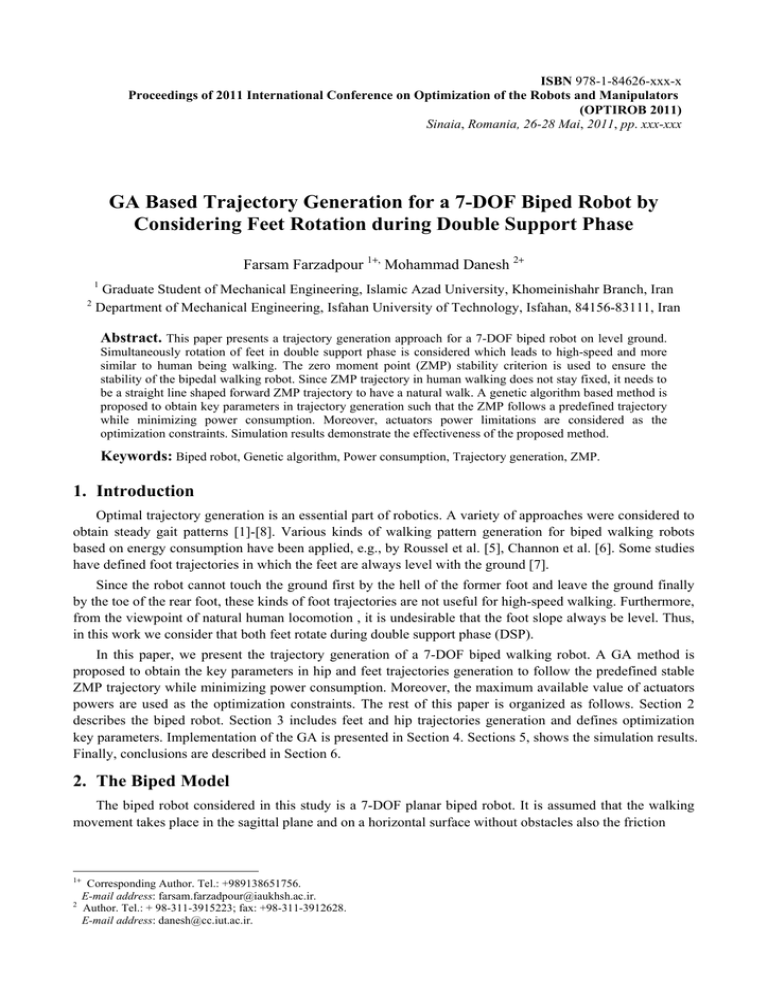
ISBN 978-1-84626-xxx-x Proceedings of 2011 International Conference on Optimization of the Robots and Manipulators (OPTIROB 2011) Sinaia, Romania, 26-28 Mai, 2011, pp. xxx-xxx GA Based Trajectory Generation for a 7-DOF Biped Robot by Considering Feet Rotation during Double Support Phase Farsam Farzadpour 1+, Mohammad Danesh 2+ 1 2 Graduate Student of Mechanical Engineering, Islamic Azad University, Khomeinishahr Branch, Iran Department of Mechanical Engineering, Isfahan University of Technology, Isfahan, 84156-83111, Iran Abstract. This paper presents a trajectory generation approach for a 7-DOF biped robot on level ground. Simultaneously rotation of feet in double support phase is considered which leads to high-speed and more similar to human being walking. The zero moment point (ZMP) stability criterion is used to ensure the stability of the bipedal walking robot. Since ZMP trajectory in human walking does not stay fixed, it needs to be a straight line shaped forward ZMP trajectory to have a natural walk. A genetic algorithm based method is proposed to obtain key parameters in trajectory generation such that the ZMP follows a predefined trajectory while minimizing power consumption. Moreover, actuators power limitations are considered as the optimization constraints. Simulation results demonstrate the effectiveness of the proposed method. Keywords: Biped robot, Genetic algorithm, Power consumption, Trajectory generation, ZMP. 1. Introduction Optimal trajectory generation is an essential part of robotics. A variety of approaches were considered to obtain steady gait patterns [1]-[8]. Various kinds of walking pattern generation for biped walking robots based on energy consumption have been applied, e.g., by Roussel et al. [5], Channon et al. [6]. Some studies have defined foot trajectories in which the feet are always level with the ground [7]. Since the robot cannot touch the ground first by the hell of the former foot and leave the ground finally by the toe of the rear foot, these kinds of foot trajectories are not useful for high-speed walking. Furthermore, from the viewpoint of natural human locomotion , it is undesirable that the foot slope always be level. Thus, in this work we consider that both feet rotate during double support phase (DSP). In this paper, we present the trajectory generation of a 7-DOF biped walking robot. A GA method is proposed to obtain the key parameters in hip and feet trajectories generation to follow the predefined stable ZMP trajectory while minimizing power consumption. Moreover, the maximum available value of actuators powers are used as the optimization constraints. The rest of this paper is organized as follows. Section 2 describes the biped robot. Section 3 includes feet and hip trajectories generation and defines optimization key parameters. Implementation of the GA is presented in Section 4. Sections 5, shows the simulation results. Finally, conclusions are described in Section 6. 2. The Biped Model The biped robot considered in this study is a 7-DOF planar biped robot. It is assumed that the walking movement takes place in the sagittal plane and on a horizontal surface without obstacles also the friction 1+ 2 Corresponding Author. Tel.: +989138651756. E-mail address: farsam.farzadpour@iaukhsh.ac.ir. Author. Tel.: + 98-311-3915223; fax: +98-311-3912628. E-mail address: danesh@cc.iut.ac.ir. SSP DSP t = 0 S1 t = Td S2 t = Tc S1 q4 0 < α1 < qb 0 < α2 < q f L l an l f a l ab Hip trajectory ( X h , Yh ) R L R Swing foot q3 trajectory q5 α1 ( xa , ya ) ( X s , Ys ) q7 qb qf ym ( xb , yb ) Y q 1 q2 xm O Ds L ( X a , Ya ) t = Tm q6 R qb O X O Fig. 1: The sagittal configuration of the biped. between the feet and the ground is sufficient to prevent slippage. One of the stability measure criterions for the legged locomotion is a ZMP criterion proposed by Vukobratovic [9] which is a point on the surface about which the sum of all moments of active forces and momentums are equal to zero. Schematic representation of the biped walking model is depicted in Fig. 1 and the values of the model parameters are listed in Table I. 3. Trajectory Generation 3.1. Hip Trajectory Stability of the biped walking robot is strongly affected by horizontal hip motion. Therefore, to have a stable walking special care should be taken in defining the horizontal motion of the hip. Subsequently, the following conditions should hold ⎧− S : t = kTc Xh = ⎨ 1 ⎩ Ds − S1 : t = (k + 1)Tc ; X h (kTc) = X h ((k + 1)Tc) Xh (kTc) = Xh ((k + 1)Tc) (1) where k is the step number. According to boundary conditions for horizontal motion of the hip we consider a 6th order polynomial that contain three extra coefficients according to the number of required constraints (redundant coefficients) and select them as ( a2 , a6 , a7 ) to search in GA. X hDSP = a0 + a1t1 + a2 t 2 + a3t 3 + a4 t 4 + a5t 5 + a6 t 6 (2) One desire feature of biped robot gait is to keep minimum vertical motion of the gravity center, which requires minimum vertical motion of the hip. Hence, Yh will be selected as a free constant parameter to be obtained by GA. 3.2. Feet Trajectory In addition to the horizontal hip motion, feet trajectories have an important role in trajectory generation, thus feet motion is included in optimization process. During DSP, the ankle joints of swing and stance foot should rotate about their toe and heel respectively. Thus, the boundary conditions for stance foot are ⎧qb ⎩0 α1 (t ) = ⎨ ; t = kTc ; t = kTc + Td ; α1 (kTc) = α1 (kTc + Td ) = 0 α1 (kTc + Td ) = 0 (3) Table I: Parameters of the biped robot. -Walking Parameters -GA Parameters Torso Thigh Shin Foot Optimization Parameters Trajectory Generation GA Operation Mutation Dynamic Simulation Fitness Evaluation IndivNo GeNo Reproduction 200 300 No GN = GN max Yes Optimal values of parameters Length (m) 0.30 0.35 0.35 0.33 Inertia (Kg.m^2) 1.9350 0.6125 0.349 0.0456 Table II: GA parameters. Crossover Crossover Rate 80% Mutation Rate 1% Table III: Optimization results. GN = GN + 1 Optimal solution found ?Or Mass (kg) 43 10 5.7 3.3 Parameters -GN=1 Parameters a2 -0.5874 c6 -7.2710 g8 1.3209 a3 2.2038 d2 -0.5215 g9 4.6845 a4 -0.5780 d4 0.3275 xm 0.1000 b2 -11.8693 d6 0.9640 ym 0.2050 b6 2.7414 e2 0.9660 S1 0.1382 b7 2.2042 e7 0.1249 qb 0.200 c2 -1.5587 e8 2.1305 qf -0.200 c5 -16.5461 g2 0.0616 Yh 0.6458 Fig. 2: Flow chart of the genetic algorithm. Regarding to the above conditions, we need at least a polynomial with five coefficients and selecting three redundant coefficients as ( b2 , b6 , b7 ) give us more control on stance foot trajectory generation. The boundary conditions for swing foot are ⎧⎪0 ; t = kTc ⎪⎩q f ; t = kTc + Td α 2 (t ) = ⎨ (4) Proceeding in a similar way, for swing foot by adding three redundant coefficients ( c2 , c3 , c4 ) we need a 4th order polynomial. In SSP (Single Support Phase) according to Fig. 2, horizontal motion of swing foot specified by three points, xa , xm and xb , such that the via points are reached at times (kTc + Td ) , (kTc + Tm) and ((k + 1)Tc) , respectively. Avoidance of impact reduces the control difficulty and enhances the system stability. This achieved by keeping the velocity of the swing heel-touch zero before the impact. Regarding to repeatability and continuity conditions, seven constraints need to be satisfied by the trajectory. Therefore, with three redundant coefficients ( g 2 , g8 , g9 ) we have a 9th order polynomial. In a similar manner, vertical motion of the swing foot is defined by three points ya , ym and yb . We assume that vertical acceleration of swing foot at time (kTc + Tm) is zero. Considering repeatability and continuity conditions we have nine constraints to be satisfied. According to large numbers of constraints, swing foot trajectory will be divided into two 8th order polynomial segments with three redundant coefficients for each. These six extra coefficients are selected as d 2 , d 4 , d 6 and e2 , e7 , e8 . 4. Genetic Algorithm Implementation The fitness function of this algorithm is min F = ω1 ( 1 n 1 n J X zmp − X zmpd ) + ω2 ( ∑∑ τ i qi dt ) ∑ n n i =1 (5) where X zmp is the current ZMP location with respect to the reference coordinate located at the heel end and X zmpd is assumed to be desired ZMP, J is the number of joints of the biped robot, τ i , qi are the actuator torque and joint angular velocity of the ith joint, respectively, ω1 and ω2 are the weighting factors. It is assumed that the actuators have no mechanical power regeneration, and the absolute value of the mechanical power is used in cost function. Also it is possible to avoid the situation where the amount of the power supplied to the actuators exceed the maximum available values by defining following inequality as the optimization constraints Ci = τ i qi − Pmi ≤ 0 , i = 1, 2..., 6 (6) where Pmi is maximum actuator power of ith joint. Flowchart of the GA based approach is illustrated in Fig. 2. 5. Simulation and Results In this section, 24 key parameters in trajectories generation are searched by GA. DSP duration is Td = 0.18s and SSP ends at Tc = 1s . Maximum clearance of the swing foot occurs at Tm = 0.58s . Also Ds=0.37, the maximum actuators powers of joints are selected as follows: Pm1 = Pm 2 = 80 w Pm 3 = Pm 4 = Pm 5 = 60 w Pm 6 = 30w Fig. 3: The details of hip trajectory of the biped robot. Fig. 5: The total power in half of the cycle. Fig. 4: Joint trajectories in half of the cycle. Fig. 6: The actuators power. Table II, shows the initial conditions for GA where IndivNo is the number of individuals, and GenNo is the number of generations. Fig. 3 illustrates the details of the optimal hip trajectory of the biped robot. The converged values of the interested parameters are listed in Table III. Once these parameters are known it is possible to define the trajectories of feet and hip. Joint trajectories in half of a walking cycle are presented in Fig. 4. And corresponding total power of all actuators is shown in Fig. 5, and its maximum value is 236w. The power of all actuators illustrated in Fig. 6, Fig. 7 shows the resulting ZMP trajectory of the biped. When two legs are touching the ground, the upper bound is the heel of the front foot, and the lower bound is the front of the back foot drawn by dashed and dotted lines, respectively. Stick diagram of the walking robot for half of a walking cycle (Tc=1s) is shown in Fig. 8. Fig. 7: The resulting ZMP trajectory of the biped. Fig 8: Stick diagram of the walking robot. 6. Conclusions In this paper, an optimal motion trajectory is derived for a 7-DOF biped robot that has simultaneously rotation of feet in DSP. According to Fig. 3 and 4, repeatability and continuity of gait variables are obtained. Result shows that using polynomial with redundant coefficients for feet trajectories can significantly improve the optimization results. Minimum power consumption was achieved and the mechanical power supplied to the actuators did not exceed their maximum permitted value. It is shown that the robot accurately followed the predefined stable ZMP trajectory and has a small deviation. These conclusions confirm the validity and effectiveness of the proposed method. 7. References [1] K. Erbatur, O. Kurt, Humanoid walking robot control with natural ZMP references, Proc. of IEEE Industrial Electronics, IECON 2006 - 32nd Annual Conference, France, Nov. 2006, pp. 4100 - 4106. [2] C. M. Chew, G. A. Pratt, Dynamic bipedal walking assisted by learning, Robotica, vol. 20, 2000, pp. 477-491. [3] T. Sugihara, Y. Nakamura, H. Inoue, Real time humanoid motion generation through ZMP manipulation based on inverted pendulum control, Proc. of IEEE Int. Conf. on Robotics and Automation, Washington DC, May 2002. [4] C. Q. Huang, et al, Planning walking patterns for a biped robot, IEEE Transactions on Robotics and Automation, vol. 17, no. 3, June 2001, pp. 280-289. [5] L. Roussel, C. Canudas-de-Wit, and A. Goswami, Generation of energy optimal complete gait cycles for biped robots, Proc. of IEEE Int. Conf. on Robotics and Automation, 1998, pp. 2036-2041. [6] P. H. Channon, S. H. Hopkins, and D. T. Phan, Derivation of optimal walking motions for a biped walking robot, Robotica, vol. 10, no. 2, 1992, pp. 165-172. [7] Y. Hasegawa, T. Arakawa, and T. Fukuda, Trajectory generation for biped locomotion robot, Journal Mechatronics, vol. 10, 2000, pp. 67-89. [8] G. Capi, S. Kaneko, K. Mitobe, L. Barolli, and Y. Nasu, Optimal trajectory generation for a prismatic joint biped robot using genetic algorithms, Robotics And Autonomous Systems, vol. 38, 2000, pp. 119-128. [9] Q. Huang, K., et al, Planning walking patterns for a biped robot, IEEE Transactions on Robotics and Automation, vol. 17, no. 3, 2001, pp. 280-289.
